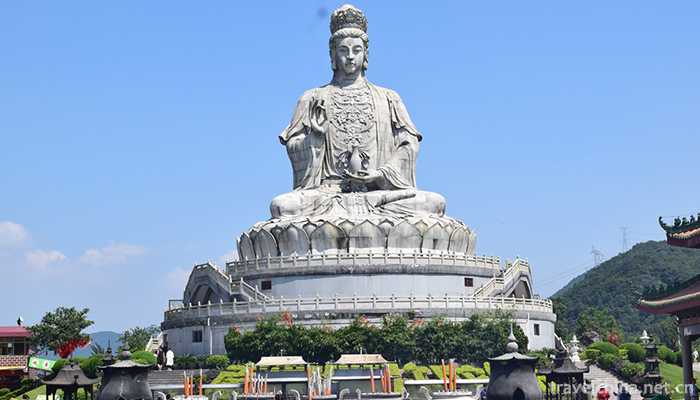Guanyin legend
Guanyin legend
Guanyin legend is one of the ancient local folklores in Zhoushan, Zhejiang Province. It is one of the second batch of national intangible cultural heritage list published by the State Council. The goodness of Guanyin's great compassion and the virtue of saving suffering and rescuing sufferings have been widely believed in among the Chinese people, and have been spread to Japan and Southeast Asian countries for a long time. With its extensive and profound Guanyin culture and beautiful natural scenery, Putuo Mountain attracts a large number of fragrant tourists every year. These cultural and realistic backgrounds are the solid foundation for the Guanyin legend to be listed in the national intangible cultural heritage list and declared as the world intangible cultural heritage.
On June 7, 2008, the legend of Guanyin was approved by the State Council to be included in the second batch of national intangible cultural heritage list.
Historical origin
The popularity of "Guanyin Legend" is closely related to the widespread belief in local Guanyin. As early as in Song Baoqing's Changguo County Chronicle, there was a record of "Meizen Mountain (today's Putuo Mountain) Guanyin Baotuo Temple". Song Qiandao's "Four Mings Tujing" is a record of "Japanese monk Hui-e delivering Guanyin", and the legend of "refusing to go to Guanyin" has been circulating ever since, and has become an important link of cultural exchanges between China and Japan. Sheng Ximing, a monk in the Western Regions of the Yuan Dynasty, wrote "Biography of Putuo Luo Mountain", and also recorded "Good Money 18 Visits from Zi", "Guan Shiyin 32 Appearing Like Sayings" and "Chaoyin Cave of Sanskrit Monks in the Middle Tang Dynasty". The first ten burnt fingers witnessed the myth of Datu Guanshen and so on. Since the Ming and Qing Dynasties, the Records of Mount Putuo have recorded more myths about Guanyin. The twelve-year-edition of the New Records of Putuo Luoga, a monograph on "Spiritual Gates", recorded 68 myths about various kinds of Guanyin. In addition to the ancient records, as early as the Ming and Wanli Dynasties, the book Guanyin Quanzhuan in the South China Sea was circulated among the people, and in the early years of the Republic of China, the script of Guanyin Dedao was handed down among the people. The legendary image of Guanyin is recorded in classical novels such as Journey to the West and Romance of Fengshen. According to Buddhist legend, the nineteenth of February, nineteenth of June and nineteenth of September in the lunar calendar are the birth, monkhood and Taoism of Guanyin Bodhisattva respectively. They are called the three fragrant clubs. Each day has a story. Therefore, for thousands of years, as a great Bodhisattva with boundless Buddhism and Dharma, Guanshi has been widely praised and believed in folk quilts in Zhoushan. Moreover, this kind of eulogizing and believing in oneself goes far beyond the national and national boundaries, and becomes a kind of Guanyin cultural phenomenon of "persuading people to do good and loving peace" which has spread to all parts of the world.
primary coverage
Among the many Bodhisattvas offered by Buddhism, the most familiar and affectionate one is probably the Guan Shiyin Bodhisattva. Guan Shiyin is a free translation of Sanskrit, also known as Guan Shiyin, Guan Zi and Guan Shi Zi. In the Tang Dynasty, Guan Shiyin was slightly called Guan Yin because it avoided the taboo of Taizong Li Shimin. According to Indian legend, Guanyin Bodhisattva was originally the great prince of the Saint King of the Wheel. He practiced with his brother and served Amitabha Buddha, becoming one of the "Three Saints of the West". Guanyin has the virtue of "great kindness and happiness of all living beings, great compassion and suffering of all living beings". It can present thirty-two incarnations and save twelve kinds of great hardships. Since the Sui and Tang Dynasties, the belief in Guanyin has become popular among the people with the prosperity of Buddhism. The image of Guanyin has gradually departed from the Indian legend pattern and replaced it with the Chinese female image.
According to legend, Mount Putuo is the Taoist arena of Guanyin's manifestation theory. On the 19th of February, 19th of June and 19th of September in the lunar calendar, the legendary Birthday, Sunday and Nirvana Day of Guanyin Bodhisattva come thousands of miles away. The legend of Guanyin is also widely spread here.
Inheritance significance
Mount Putuo has a profound Buddhist culture and has become the belief of Guanyin, which has been claimed to be the belief of most of Asia with the Sinicization of Buddhism. As long as there are Chinese people in the world, they all know Guanyin. The vast majority of Buddhists are Guanyin believers. Protecting and excavating Guanyin culture and promoting the positive connotation of Buddhist culture are good carriers for us to inherit historical culture and build a harmonious society. At the same time, they are people's expectations.
Today, when we build a harmonious world, we should give full play to the special role of Guanyin culture and Guanyin belief, which is a cultural treasure, to benefit all living beings. Because Guanyin culture belongs to Mount Putuo, to the Chinese nation, and even to the human civilization of the whole world.


-
2.Wuyuan County
Wuyuan County, now under the jurisdiction of Shangrao City, Jiangxi Province, is one of the six counties in ancient Huizhou.
Time 2018-11-11 -
3.Expo Area of Acient Kiln & Folk Cultures in Jingde
Jingdezhen Ancient Kiln Folklore Expo Area, located in Fengshu Mountain and Panlonggang, Changjiang District, Jingdezhen City, Jiangxi Province
Time 2018-12-08 -
4.Flaming Mountains
Flame Mountain in Xinjiang is the most famous scenic spot in Turpan. Located in the northern margin of Turpan Basin, the northern route of the ancient Silk Road is mainly composed of red sand
Time 2019-01-19 -
5.Taoist Drama
Taoist sentiment is a category of traditional Chinese folk art. It originated from Taoist songs such as Chengtian and Jiuzhen in Tang Dynasty. The Southern Song Dynasty began to accompany with fishing
Time 2019-04-25 -
6.Wunijing Handmade Cotton Textile Technology
Wunijing handmade cotton textile technology has a very long history in China. Cotton and hemp textiles first appeared in the Neolithic Age. The handmade cotton textile technology in the Tang Dynasty w
Time 2019-06-29 -
7.Sibo Belem Dance
"Bailun" dance is the generic name of Xibo self-entertainment dance and the first type of Xibo folk dance. It originated from an ancient dance that imitated life and production posture in th
Time 2019-07-01 -
8.Sintering Techniques of Xingyao Ceramics
Xingyao firing technology is a local traditional handicraft in Hebei Province. Xing kiln is a famous northern kiln in China. As early as the Northern Dynasty, Xing kiln began firing celadon and a smal
Time 2019-07-08 -
9.Sichuan Conservatory of Music
Sichuan Conservatory of Music, whose predecessor was "Sichuan Provincial Drama Education Experimental School" founded in 1939, has experienced such periods as "Sichuan Provincial Music
Time 2019-08-31 -
10.Nanchongs tertiary industry
In 2019, investment in real estate development in Nanchong will increase by 23.6% compared with that in 2018. The construction area of commercial housing was 31.8726 million square meters, an increase of 23.5% over that in 2018, of which the newly started
Time 2020-12-17 -
11.Dazhous first industry
In 2019, the annual grain planting area of Dazhou city is 556900 hectares, an increase of 0.3% over the previous year. Among them, rice was 191500 ha, an increase of 0.2%; maize was 137500 ha, an increase of 0.9%; potato was 162000 ha, a decreas
Time 2020-12-20 -
12.Dazhou environmental protection
In 2019, the afforestation area of Dazhou city is 11666.60 hectares, the forest area is 735300 hectares, and the forest coverage rate is 44.34%. The air, water and soil pollution prevention and control were carried out in depth. The air compliance rate
Time 2020-12-20